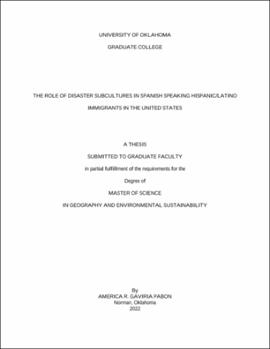| dc.description.abstract | Having a diversity of climatic zones, the United States experiences different weather hazards and risks such as winter storms, tornados, droughts, hurricanes, among others depending on the geographic location. With Americans having a culture geared towards becoming a weather-ready nation, they may be more familiar with their emergency system than other communities living in the United States. According to the U.S. 2020 Census, Hispanics in the U.S. account for 18.9% of the total population, making them the second largest ethnic group. Coming from different places and having a diverse cultural background, the Hispanic/Latino community may be more vulnerable towards these hazards and disasters due to their lack of experience with such events in their country of origin and other factors such as language barriers. Hispanic/Latino Spanish speaking communities in the U.S. come from different places and depending from where one comes, some people may have different cultures of disaster response, or disaster subcultures. When it comes to understanding, interpreting, and acting on different information regarding weather and climate threats these factors can play a significant role. Additionally, inequities in weather risk communication such as translations from English to Spanish may also increase the vulnerability and challenges that this community faces when it comes to weather hazards. This research analyzes how cultural background and experiences or disaster subcultures from Hispanic/Latino immigrants in the United States affects the way they perceive, understand and act on severe weather risks. Using data from the Severe Weather and Society Survey 2022 Spanish version we analyze the differences between people who lived outside the U.S. versus people who did not and their perceptions, behaviors, and reporting understanding of severe weather risks. When doing the analysis, language barriers will also be taken into consideration. In addition, we also perform a qualitative analysis using data from interviews held after the December 10th, 2021, tornado outbreak within the Guatemalan community of Mayfield, KY. These results are presented and discussed using a disaster subcultures frame. When communicating different weather risks and threats, the weather enterprise needs to consider factors such as culture and experience to effectively communicate and transmit their weather risk information to diverse communities such as Spanish speaking Hispanic/Latinos. | en_US |

